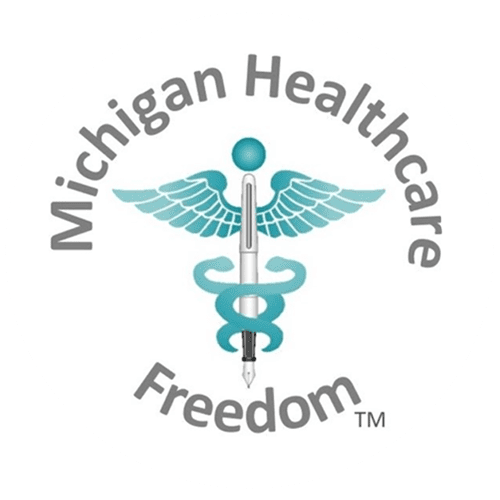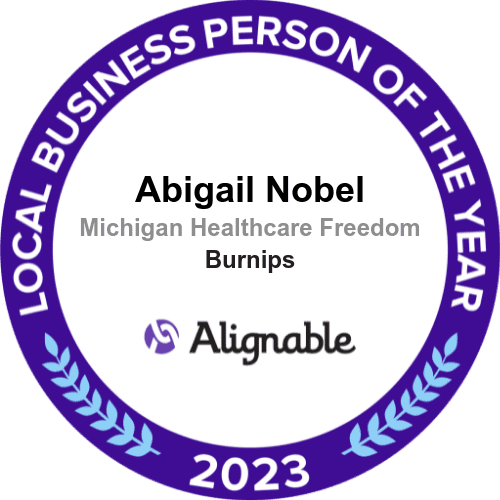
The U.P.'s northwestern county, Ontonagon, just lost its only hospital:
U.P. county loses its only hospital in what residents call ‘life or death situation’
Hospital shuts down at midnight, barricades go up, signs get covered. Roadside hospital signs gone, too.
By Jennifer Dixon - April 30, 2024A minute before midnight on Friday, April 19, the only hospital in one of Michigan's largest counties stopped taking emergency patients. Shortly afterward, tarps covered the signs at the Aspirus Ontonagon Hospital at the western edge of the Upper Peninsula, barricades were erected, lights out.
Earlier that same Friday, crews from the Michigan Department of Transportation removed three blue roadside hospital signs in the Village of Ontonagon. And all of a sudden this small, rural community on the shores of Lake Superior no longer had a hospital or an emergency room.
The closest emergency room is now a 45-minute drive away — a treacherous and even longer trip in a fierce U.P. winter storm.
"I feel robbed of our economic future. It's really a crisis," said resident Cheryl Sundberg, who runs a summer music festival in the nearby Porcupine Mountains.
Indeed, experts say, the economy of a community and the health of its hospital are closely intertwined: Can a community without a hospital attract new businesses, new teachers, new residents? At the same time, hospitals create jobs and keep local businesses like florists or landscapers afloat.
Aspirus, a nonprofit chain of hospitals based in Wausau, Wisconsin, gave the community two months' notice that it was closing its Ontonagon hospital, despite earlier promises that it would build a new, $15.8 million facility with inpatient beds and an emergency department.
On same day in February that it announced it was ending emergency services and turning the hospital in Ontonagon into a clinic, Aspirus announced a $30 million investment in another Upper Peninsula hospital.
Aspirus first announced the new building for Ontonagon in September 2021 and in a March 2022 news release said plans for the hospital were being finalized, according to a Feb. 29 letter to the Aspirus president and CEO, Matthew Heywood, from U.S. Rep. Jack Bergman, state Sen. Ed McBroom, and state Rep. Gregory Markkanen, all Republicans.
The lawmakers' letter said it appears that news release is "no longer available to view on the Aspirus Health's website." The Free Press left messages with two Aspirus officials, which were not immediately returned.
But in response to the lawmakers' letter, Aspirus said the decision to turn the Ontonagon hospital into clinic, was "not about money."
Health care needs in Ontonagon have changed, and the hospital was seeing an average of just one patient a day, and an average of five patients a day in the emergency department. And up to half of those emergency patients could be treated more effectively in a clinic, the hospital said in its response to lawmakers.
"These realities lead us to transition our services to best benefit the community," the letter said, citing same-day primary care at the clinic, along with lab and imaging services, a pharmacy, and occupational, speech, and physical therapy.
Mega mergers:As large Michigan health systems merge, independent hospitals are vanishing
The clinic will be open weekdays, 8 a.m. to 5 p.m., according to the Aspirus website.
Aspirus said it remains committed to the Upper Peninsula, including making significant improvements at its hospital in Ironwood and a $30 million investment in its hospital in Laurium, in the Keweenaw Peninsula. It has a third U.P. hospital in Iron River and about a dozen others in Wisconsin.
But as a nonprofit health system serving a vast geographic and mostly rural area, Aspirus said it must thoughtfully leverage its resources "in ways that best meet changing community needs."
It noted that since 2010, more than 80 rural hospitals have completely closed and more than 65 converted to new models. These closures have been driven, in part, experts say, by changing demographics, difficulties in recruiting doctors and other staff, rising costs, and dwindling revenues.
Aspirus bought the hospital in Ontonagon from the village for $1 in 2007, and the village agreed to cover the pension liability for 134 former employees.
"This favorable arrangement for Aspirus was made to ensure that health services would be able to be maintained for residents and visitors in the Ontonagon area," the three lawmakers said in their letter.
Michigan now has a dozen rural counties with no acute care hospital, and a 13th county, Cheboygan, doesn't have a hospital but does have access to emergency services through McLaren Northern Michigan's campus in the city of Cheboygan, according to the Michigan Health & Hospital Association.
"It's a hard business," said Mark Holmes, director of the Sheps Center for Health Services Research at the University of North Carolina at Chapel Hill, which tracks rural hospital closures.
Now that they're without their hospital, residents of Ontonagon are worried: for their health; for the hundreds of thousands of hikers and other visitors who come to the Porcupine Mountains every year and the inevitable ones who get lost or injured; for the employees of local businesses hurt on the job; and for their community's economic future.
"I don't know how you have a community without a hospital and schools," said Marty Fittante, chief executive of InvestUP, which promotes economic development in the Upper Peninsula. "A hospital is foundational to a community."
J.R. Richardson, who was on the Aspirus UP regional board until January 2024, said Ontonagon once had a paper mill, a copper mine, and a ship-building company. However, the lack of an emergency room will "deter further business development."
Richardson said the community is planning a picnic on June 8 in appreciation of hospital employees.
Ken Waldrop, a member of the Ontonagon Village Council, said local leaders tried to persuade Aspirus to keep the hospital open and even turned to the governor's office. He and others said their pleas were not heard.
"It was a cry for help from up here that went unheard," Waldrop said.
And now, Richardson said, "it's a life or death situation."
U of M's Michigan Daily ran a good article on geography-based health disparities in Michigan:
Exploring geography-based health disparities in Michigan
By Emma Lapp - April 24, 2024Over the past few decades, access to health care in rural areas has been declining in the U.S. More than 100 rural hospitals closed between 2013 and 2020. Due to the distance of health care facilities from rural communities, people living in rural areas are more likely to die of heart disease, respiratory disease, cancer, stroke or from unintentional injury.
In Michigan, certain areas including the Upper Peninsula and the northeastern part of the Lower Peninsula have been deemed medically underserved due to location. There are only 15 hospitals in the Upper Peninsula, and many of them offer limited services; the Marquette General Health System is the only hospital in the region that provides cardiac catheterization.
Areas are deemed “underserved” when they are experiencing a physician shortage, hospital closures or issues with job recruitment. According to the Michigan Center for Rural Health, there are two types of shortage designations: Health Professional Shortage Area and Medically Underserved Area/Population. HPSA defines the shortage of primary, mental health and dental care providers and a MUA/P is defined by the limited access to primary care for a specific group within an area.
About 20% of Michigan residents live in rural areas. The Michigan Daily spoke to researchers from three studies that examined disparities in melanoma cases, opioid overdose rates and access to maternity care in rural Michigan. All of these studies provide context for how best to address health care disparities based on location.
A study on melanoma incidences and mortality showed that cutaneous melanoma rates were much higher in rural Michigan counties compared to urban counties. Cutaneous melanoma is a cancer that stems from the pigment-making cells in the skin. Research has shown the primary cause of CM is exposure to ultraviolet radiation from the sun or tanning beds. This study used multiple factors in the analysis: gender, age and area of residence from 2014 to 2018. This data was collected from the Michigan Department of Health and Human Services and the Centers for Disease Control and Prevention.
Richard Shellenberger, Trinity Health doctor, melanoma researcher and author of the study, spoke with The Daily about the results of the study.
“When you have differences in cancer rates, you don’t know exactly what they are caused by,” Shellenberger said. “Just because you live in a rural area doesn’t mean that you living there (has) caused you to have disparities. So we wanted to see if there were differences in race, gender, economic status and insurance status. We found that the incidence rates for cutaneous melanoma were significantly higher in the rural areas than they were in urban areas. These results were found across all age groups, genders and stages of disease.”
According to Shellenberg, it is difficult for some Michigan residents to access dermatologists for melanoma treatment, especially in the Upper Peninsula.
“We tried to find if there were dermatologists in all of the Michigan counties,” Shellenberger said. “We found that some of the counties in Michigan not only don’t have a dermatologist, but they don’t even have a doctor in their county. In the Upper Peninsula, there was only one dermatologist we could identify.”
Shellenberger said he has plans to continue this research with a broader data set including different types of cancers.
“We are planning on doing a similar study but for the top 10 cancers in incidence and the top 10 cancers in mortality,” Shellenberger said. “We have already done some preliminary research and we found that there are similar increases in rural areas, like what we saw in the melanoma study. I think this is going to be a wake-up call for public health because we don’t have enough doctors in rural areas. ”
A 2020 study on opioid prescribing and overdosing also highlighted disparities between rural and urban counties in Michigan. Results from this study found urban counties had consistently higher opioid-overdose death rates; however, rural counties had higher prescription rates. This study used public data from 2013 to 2017 and the counties were classified as either rural or urban using Rural Urban Continuum Codes.
Jennifer Ellis, one of the study authors and clinical psychologist at Johns Hopkins Medicine, worked on this study as part of her graduate training at the Wayne State School of Social Work. In an interview with The Daily, Ellis said she was initially surprised by the results but was later able to identify some potential causes for their observations.
“I think that the reason opioid prescribing was higher in rural counties, but the death rates were higher in urban counties, is at this point in time or the years where this data was collected from, a lot of the opioid overdose death rates were less being driven by prescription opioids and were more commonly being driven by things that were entering the heroin supply,” Ellis said. “Things like fentanyl were driving these deaths.”
After observing this rise in opioid deaths, Ellis and other researchers became interested in seeing if there was a connection to location.
“Rural and urban comparisons are particularly relevant to the conversation of opioids given that people in rural areas often have fewer treatment options and it takes longer for emergency services to arrive,” Ellis said. “So we thought this could be a really interesting area of research to look into.”
According to Ellis, there are substantial rural and urban differences in terms of the availability, accessibility and acceptability of treatment for opioid use disorder.
“In rural areas, just because people tend to be more spread out, a lot of the time people have to travel a lot of miles to get to an opioid treatment program,” Ellis said. “There has really been a push to increase treatment availability for people living in rural areas. On the flip side, in urban areas, sometimes it is more common for people to have transportation problems. It is more common for people to rely on public transportation when they are living in urban areas. Depending on what city you live in, the public transportation may or may not be very good.”
In an email to The Daily, Jamey Lister, lead author of the study and associate professor at Rutgers University School of Social Work, wrote about the benefits of interventions such as prescription drug monitoring programs. Michigan Automated Prescription System is working as an aid to prescribers to help flag patients who might be improperly seeking or using medications.
“From a policy perspective, responsible opioid prescribing initiatives are one strategy to limit overprescribing and in the process provide greater access to pain medication that can be addictive,” Lister wrote. “Those initiatives are most commonly referred to as prescription drug monitoring programs. Those programs have been shown to work best when people who are addicted to their pain medication are linked to treatment, offering buprenorphine or methadone, as opposed to ending their opioid prescriptions without an aftercare plan.”
According to Lister, including discussion of this disparity in governmental settings is extremely important, given certain stigma around the topic.
“More broadly, disparities across the spectrum of health conditions and ‘diseases of despair’ have been worsening in rural communities, a phenomenon sometimes called the rural mortality penalty,” Lister said. “It is essential that leaders across governmental, health department, and academic sectors initiate and sustain equal partnerships with rural leaders as a means of building trust and helping better address the needs, concerns, and solutions of rural residents.”
Another area of concern in the topic of location disparities is access to maternity services. Researchers from Michigan State University found decreased access to maternity and prenatal care services in rural counties in Michigan. This study found that in the 57 declared rural communities in Michigan, 29 hospitals have operating labor and delivery units. Researchers worked with Michigan Medicaid to identify billings from hospitals to determine which hospitals included which services.
The hospitals with labor and delivery services are mainly located in the southern and western parts of the Lower Peninsula. This leaves some people living in the Upper Peninsula and northeastern Lower Peninsula having to travel more than 100 miles to get maternity and prenatal care.
In an interview with The Daily, Andrea Wendling, director of rural medicine at MSU and author of the study, explained that the study used data from Medicaid to identify which hospitals were billing which services in Michigan.
“So with the data from Medicaid, we were able to map out where women were delivering in rural Michigan communities,” Wendling said. “We only looked at rural hospitals because we wanted to understand what care was provided in their own communities. The only piece of this that we are missing is anyone who doesn’t go through the Medicaid system or a typical billing system. So we did not have any home births in our data because we weren’t able to track that.”
People who have had a cesarean section are more likely to have difficulties during later vaginal births. Wendling said people desiring a vaginal birth after cesarean section have to go through a trial of labor, which is not offered at many rural hospitals.
“If women have had a previous C-section, the trouble is that even though these hospitals provide maternity care, not many of them offer the option to women to have a trial of labor after a C-section,” Wendling said. “This takes their choice away from women just because of their zip code.”
Wendling said that in order to make real change in geographic health disparities, more people need to be involved in addressing the issue.
“I think you have to have enough of an understanding of a problem to come up with solutions that are going to work for states that are underrepresented in research,” Wendling said. “Caring enough about a problem to really understand it is a big piece to addressing this issue.”
Licensing is a barrier to the professions. It depresses initiative and increases shortages.
This situation is a great example. Licensing Michigan midwives in 2015 required them to conform to standardized courses and test, work under physician supervision, and more. There was already a physician shortage at the time, but midwives covered multi-county areas and saw moms in their homes independently.
The net effect of licensing was to drive rural midwives out of business or into the cities in order to comply with the physician requirement and make more money to pay for the higher costs of doing business. The direct entry (apprenticeship) path to midwifery became illegal.
More about Michigan licensing failures here.






